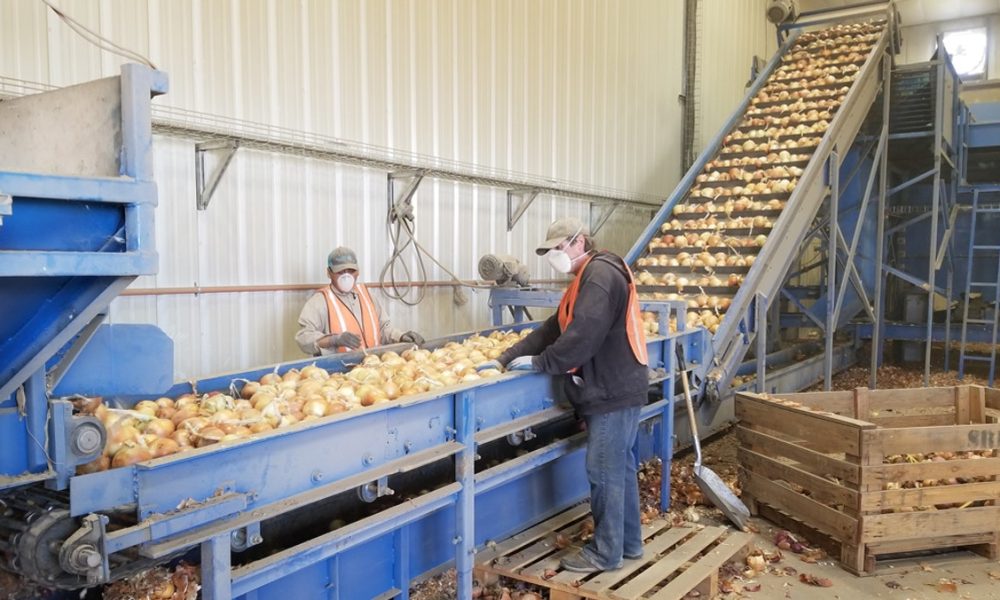 Workers at Snake River Produce in Nyssa sift through onions and remove debris last week. The local onion harvest is now in full swing and farmers and packers said it is going well. (The Enterprise/Pat Caldwell)
Workers at Snake River Produce in Nyssa sift through onions and remove debris last week. The local onion harvest is now in full swing and farmers and packers said it is going well. (The Enterprise/Pat Caldwell)
NYSSA – The onion harvest is in full swing and it appears chaos can translate into cash.
After a dismal harvest last year, local farmers and packers say this season is shaping up to be a good one.
The onions this year are bigger and the quality is up. While prices are still not where many would like, now hovering at about $6 per 50-pound bag, that could change.
“There has been a lot happening in the world. There have been several typhoons in Asia. Plus, there was a severe earthquake in Hokkaido (Japan). Europe has been in extremely hot drought conditions,” said Kay Riley, general manager of Snake River Produce Co., a Nyssa onion packing firm.
Riley said other onion producing areas such as Wisconsin, Michigan and New York and eastern Canada are grappling with more rain impacting those harvests.
Riley said all of that could mean there will be a premium on Treasure Valley onions in the future which would boost prices.
Grant Kitamura, general manager of Baker Murakami Produce Co., in Ontario said agriculture misfortune in other nations creates “reason for optimism” regarding a climb in prices. He said this year’s crop “looks good and quality is good.”
Moderate weather helped Malheur County growers.
“We had a very nice growing season when it comes right down to it,” Riley said.
Riley said yields, for the most part, are up.
“It varies from field to field. We have some growers that have had average or below average (yields).”
Stuart Reitz, Malheur County extension agent, said this harvest is already better than the 2017 onion season.
“Yields are looking pretty good, definitely higher than last year. Some of the early harvest, the yields were looking pretty good. It seems like the crop, for the most part, has done good all season long,” said Reitz.
The 2017 onion harvest suffered because of the severe winter the region encountered. Epic levels of snow that damaged onion industry infrastructure also kept farmers out of the fields past the traditional planting time.
“We had a lot of fields along the river that stayed flooded or stayed so wet that the equipment couldn’t get in,” said Reitz.
Reitz said last year the onion yield averaged between 35 to 37 tons per acre, which was roughly 25 to 30 percent below average.
The low yield made an impact on the industry said Reitz.
“Right off the bat that is $30 million (loss) across the valley,” said Reitz. “The conditions this year were so much better.”
Much of the local onion infrastructure was repaired in the wake of the 2017 winter, increasing storage and processing capacity.
Reitz said he wouldn’t have yield data until the 2018 harvest is complete.
Reitz said Riley’s analysis of a good market because of chaos in other areas is accurate.
“Their yields will be down. And, traditionally, New York onions, for example, are tiny compared to Treasure Valley onions. They won’t have as much to ship through the winter so that creates opportunities for the onions from here,” said Reitz.
Cairo Junction onion farmer Brian Kameshige said he is pleased with the harvest so far.
“It was a nice growing season and the onions are looking good,” said Kameshige.
Kameshige and Reitz both cautioned that a supply and demand market can be unstable.
“Everything fluctuates by the markets,” said Kameshige.
Reitz said there are about 22,000 acres of onions planted on the Oregon and Idaho side of the Snake River.
“So, in a good year the Malheur county crop can be $80 million,” said Reitz.




